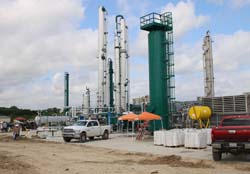Morrow Renewables, one of Garland’s newest industries, flies under the radar of residents and shares a chunk of its profit with the city. Morrow doesn’t tap into Garland’s capital or city labor. It mines Garland’s trash, turning landfill gas into energy. And the Hinton Landfill is golden.Landfill gas is created when materials in a landfill decompose. A little more than half of landfill gas is methane, the primary component of natural gas.
For decades, Garland has recognized the potential within the composition of landfill gas. But, as you could imagine, landfill gas also contains many impurities. Without the technology to separate the reusable elements of landfill gas, Garland traditionally burned off the gas.
And it wasn’t alone. According to the Environmental Protection Agency, the emissions from municipal solid waste landfills equal the greenhouse gas emissions from 21.6 million passenger cars or the carbon dioxide emissions of 12 million homes’ energy use.
Morrow has worked to perfect the cleansing of the gas. Hinton is its seventh landfill and uses technology more advanced than the previous six.
The plant is a giant filtration system. In separating the usable energy, it uses physical solvents, rather than creating chemical reactions.
At one end of Morrow’s Garland Renewables plant is the inlet from Morrow’s web of gas wells drilled into the landfill. At the other end, Atmos confirms the purity, measures the amount, pays for the gas and moves the converted energy source directly into an existing pipeline. The gas is then distributed to homes and businesses through their delivery network throughout the North Texas region.
Garland’s partnership with Morrow is also improving Hinton Landfill’s reputation as a neighbor. While Garland had the foresight to annex land far away from its residents to create the landfill, the growth in Dallas County prevented the Hinton Landfill from being truly isolated. Nearby are Rowlett’s most used park and sports fields, including its golf course. Landfill Director Chris Hoofnagle credited Rowlett for its participation in the project. The once common downwind odor of burning fumes is no more a friend to Morrow than to neighbors.
“When you smell odors on the landfill, if it’s gas, we’re losing money,” said Doug Lloyd, Morrow vice president of operations.
Morrow has made every effort to increase the amount of gas being captured and harvested. It has drilled more than 40 additional vertical wells and placed horizontal gas-capturing equipment in cells being actively filled at Hinton Landfill. More well installations are planned before the end of the year.
That alone amounts to saving the city about $500,000 in installation and $85,000 in annual operating costs.
Garland also nets a percentage of the sales of gas to Atmos. Those profits are earmarked for another environmental benefit — the federally mandated fund set aside for the eventual closing and perpetual monitoring of the landfill.
“We anticipate revenue of the level of hundreds of thousands of dollars per year,” said Jason Chessher, Garland’s managing director of public health services. “And we will be providing a significant source of renewable energy that will be used in this vicinity.”
Construction started in October 2020. The Garland Renewables plant will run 24 hours daily through the 20-year term of the agreement with the city.
Information and photo provided by city of Garland.


